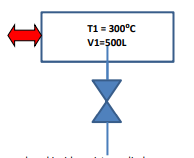
Elements Of Electromagnetics
7th Edition
ISBN: 9780190698614
Author: Sadiku, Matthew N. O.
Publisher: Oxford University Press
expand_more
expand_more
format_list_bulleted
Concept explainers
Question
Initially, a rigid tank contains 500L of water at 300°C. By volume, the tank contains60% liquid and 40% vapor. At
the bottom of the tank, as shown, a valve is opened and half of the mass of water is withdrawn which is in the
liquid phase. Heat transfer takes place such that the temperature within the tank is constant. Determine the
heat transfer in kJ required to withdraw half of its mass and maintain its temperature. (Provide Schematic Diagram if applicable)

Transcribed Image Text:T1 = 300°C
V1=500L
Expert Solution
This question has been solved!
Explore an expertly crafted, step-by-step solution for a thorough understanding of key concepts.
This is a popular solution
Trending nowThis is a popular solution!
Step by stepSolved in 2 steps with 2 images

Knowledge Booster
Learn more about
Need a deep-dive on the concept behind this application? Look no further. Learn more about this topic, mechanical-engineering and related others by exploring similar questions and additional content below.Similar questions
- HELP ME WITH THIS THERMODYNAMIC PROBLEM Subcooled water at the pressure of 10 MPa and temperature of 100°C is heated at a constant pressure process to the temperature 200°C. If the mass of water is 5 kg (a closed system), determine the work and heat transfer in the process: Using compressed liquid water property table. Using saturated water property table (approximation). Using incompressible substance equations (note that in an incompressible fluid, the volume does not change).arrow_forwardShown in the figure, an insulated rigid tank is divided into two equal parts by a partition. Initially, one part contains an indeal gas, and the other part is evacuated. The partition is then removed, and the gas expands into the entire tank. At the initial state, the mass of the gas is m= 4.00kg, initial pressure is p1 = 600.00 kPa, initial temperature is T1 = 300.00 K. The gas constant is R = 0.2870 kJ/(kg·K). (The internal energy can be determined by the equation ΔU=m·cv·(T2-T1), where cv = 0.7180 kJ/(kg·K) is the specific heat at the constant volume.) Calculate the final state temperature T2.__________ (K)arrow_forwardDuring processing in a steel mill, a 900 lb steel casting at 800°F is quenched by plunging it into a 550 gal oil bath, which is initially at a temperature of 100°F. After the casting cools and the oil bath warms, what is the final temperature of the two? The weight per unit volume of the oil is 7.5 lb/gal. (Express your answer using four significant figures.) T Farrow_forward
- Shown in the figure, an insulated rigid tank is divided into two equal parts by a partition. Initially, one part contains an indeal gas, and the other part is evacuated. The partition is then removed, and the gas expands into the entire tank. At the initial state, the mass of the gas is m= 4.00kg, initial pressure is p1 = 600.00 kPa, initial temperature is T1 = 300.00 K. The gas constant is R = 0.2870 kJ/(kg·K). (The internal energy can be determined by the equation ΔU=m·cv·(T2-T1), where cv = 0.7180 kJ/(kg·K) is the specific heat at the constant volume.) Calculate the final state pressure p2.__________ (kPa)arrow_forwardA real gas exists at 130 C and 1.2 MPa. It is known that the critical temperature and critical pressure of the gas is 374.2 k and 4.059 MPa. It is also know that the ideal gas constant (R) of the gas is 0.12 kPa-m/ S/kg-K. In the question that follows, select the answer that is closest to the true value. Use the compressibility factor (Z) to determine the specific volume in units of m/kg. ,3, Tuesday Dece mber 7 2021 5:52:58 DM CSTarrow_forward
arrow_back_ios
arrow_forward_ios
Recommended textbooks for you
 Elements Of ElectromagneticsMechanical EngineeringISBN:9780190698614Author:Sadiku, Matthew N. O.Publisher:Oxford University Press
Elements Of ElectromagneticsMechanical EngineeringISBN:9780190698614Author:Sadiku, Matthew N. O.Publisher:Oxford University Press Mechanics of Materials (10th Edition)Mechanical EngineeringISBN:9780134319650Author:Russell C. HibbelerPublisher:PEARSON
Mechanics of Materials (10th Edition)Mechanical EngineeringISBN:9780134319650Author:Russell C. HibbelerPublisher:PEARSON Thermodynamics: An Engineering ApproachMechanical EngineeringISBN:9781259822674Author:Yunus A. Cengel Dr., Michael A. BolesPublisher:McGraw-Hill Education
Thermodynamics: An Engineering ApproachMechanical EngineeringISBN:9781259822674Author:Yunus A. Cengel Dr., Michael A. BolesPublisher:McGraw-Hill Education Control Systems EngineeringMechanical EngineeringISBN:9781118170519Author:Norman S. NisePublisher:WILEY
Control Systems EngineeringMechanical EngineeringISBN:9781118170519Author:Norman S. NisePublisher:WILEY Mechanics of Materials (MindTap Course List)Mechanical EngineeringISBN:9781337093347Author:Barry J. Goodno, James M. GerePublisher:Cengage Learning
Mechanics of Materials (MindTap Course List)Mechanical EngineeringISBN:9781337093347Author:Barry J. Goodno, James M. GerePublisher:Cengage Learning Engineering Mechanics: StaticsMechanical EngineeringISBN:9781118807330Author:James L. Meriam, L. G. Kraige, J. N. BoltonPublisher:WILEY
Engineering Mechanics: StaticsMechanical EngineeringISBN:9781118807330Author:James L. Meriam, L. G. Kraige, J. N. BoltonPublisher:WILEY

Elements Of Electromagnetics
Mechanical Engineering
ISBN:9780190698614
Author:Sadiku, Matthew N. O.
Publisher:Oxford University Press

Mechanics of Materials (10th Edition)
Mechanical Engineering
ISBN:9780134319650
Author:Russell C. Hibbeler
Publisher:PEARSON

Thermodynamics: An Engineering Approach
Mechanical Engineering
ISBN:9781259822674
Author:Yunus A. Cengel Dr., Michael A. Boles
Publisher:McGraw-Hill Education

Control Systems Engineering
Mechanical Engineering
ISBN:9781118170519
Author:Norman S. Nise
Publisher:WILEY

Mechanics of Materials (MindTap Course List)
Mechanical Engineering
ISBN:9781337093347
Author:Barry J. Goodno, James M. Gere
Publisher:Cengage Learning

Engineering Mechanics: Statics
Mechanical Engineering
ISBN:9781118807330
Author:James L. Meriam, L. G. Kraige, J. N. Bolton
Publisher:WILEY